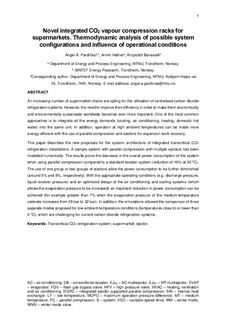| dc.contributor.author | Pardiñas, Ángel Á. | |
| dc.contributor.author | Hafner, Armin | |
| dc.contributor.author | Banasiak, Krzysztof | |
| dc.date.accessioned | 2017-12-13T09:22:11Z | |
| dc.date.available | 2017-12-13T09:22:11Z | |
| dc.date.created | 2017-12-07T08:53:07Z | |
| dc.date.issued | 2017 | |
| dc.identifier.issn | 1359-4311 | |
| dc.identifier.uri | http://hdl.handle.net/11250/2471004 | |
| dc.description.abstract | An increasing number of supermarket chains are opting for the utilisation of centralised carbon dioxide refrigeration systems. However, the need to improve their efficiency in order to make them economically and environmentally sustainable worldwide becomes ever more important. One of the most common approaches is to integrate all the energy demands (cooling, air conditioning, heating, domestic hot water) into the same unit. In addition, operation at high ambient temperatures can be made more energy-efficient with the use of parallel compression and ejectors for expansion work recovery. This paper describes the new proposals for the system architecture of integrated transcritical CO2 refrigeration installations. A sample system with parallel compression with multiple ejectors has been modelled numerically. The results prove the decrease in the overall power consumption of the system when using parallel compression compared to a standard booster system (reduction of 19% at 30 °C). The use of one group or two groups of ejectors allow the power consumption to be further diminished (around 5% and 8%, respectively). With the appropriate operating conditions (e.g. discharge pressure, liquid receiver pressure) and an optimized design of the air conditioning and cooling systems (which allows the evaporation pressure to be increased) an important reduction in power consumption can be achieved (for example greater than 7% when the evaporation pressure of the medium-temperature cabinets increases from 28 bar to 32 bar). In addition, the simulations allowed the comparison of three separate modes proposed for low-ambient-temperature conditions (temperatures close to or lower than 0 °C), which are challenging for current carbon dioxide refrigeration systems. | nb_NO |
| dc.language.iso | eng | nb_NO |
| dc.publisher | Elsevier | nb_NO |
| dc.rights | Attribution-NonCommercial-NoDerivatives 4.0 Internasjonal | * |
| dc.rights.uri | http://creativecommons.org/licenses/by-nc-nd/4.0/deed.no | * |
| dc.title | Novel integrated CO2 vapour compression racks for supermarkets. Thermodynamic analysis of possible system configurations and influence of operational conditions | nb_NO |
| dc.type | Journal article | nb_NO |
| dc.type | Peer reviewed | nb_NO |
| dc.description.version | acceptedVersion | nb_NO |
| dc.source.journal | Applied Thermal Engineering | nb_NO |
| dc.identifier.doi | 10.1016/j.applthermaleng.2017.12.015 | |
| dc.identifier.cristin | 1523928 | |
| dc.relation.project | Norges forskningsråd: 244009 | nb_NO |
| dc.description.localcode | © 2017. This is the authors’ accepted and refereed manuscript to the article. Locked until 5.12.2019 due to copyright restrictions. This manuscript version is made available under the CC-BY-NC-ND 4.0 license http://creativecommons.org/licenses/by-nc-nd/4.0/ | nb_NO |
| cristin.unitcode | 194,64,25,0 | |
| cristin.unitname | Institutt for energi- og prosessteknikk | |
| cristin.ispublished | true | |
| cristin.fulltext | postprint | |
| cristin.qualitycode | 1 | |

